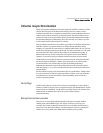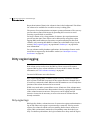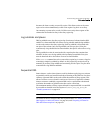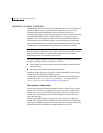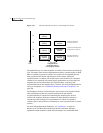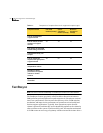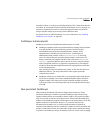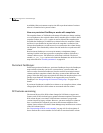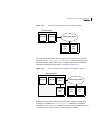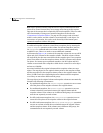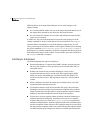
67Understanding Veritas Volume Manager
FastResync
snapshot is taken, it can be accessed independently of the volume from which it
was taken. In a clustered VxVM environment with shared access to storage, it is
possible to eliminate the resource contention and performance overhead of
using a snapshot simply by accessing it from a different node.
For details of how to enable FastResync on a per-volume basis, see “Enabling
FastResync on a volume” on page 292.
FastResync enhancements
FastResync provides two fundamental enhancements to VxVM:
■ FastResync optimizes mirror resynchronization by keeping track of updates
to stored data that have been missed by a mirror. (A mirror may be
unavailable because it has been detached from its volume, either
automatically by VxVM as the result of an error, or directly by an
administrator using a utility such as
vxplex or vxassist. A returning
mirror is a mirror that was previously detached and is in the process of
being re-attached to its original volume as the result of the
vxrecover or
vxplex att operation.) When a mirror returns to service, only the updates
that it has missed need to be re-applied to resynchronize it. This requires
much less effort than the traditional method of copying all the stored data
to the returning mirror.
Once FastResync has been enabled on a volume, it does not alter how you
administer mirrors. The only visible effect is that repair operations
conclude more quickly.
■ FastResync allows you to refresh and re-use snapshots rather than discard
them. You can quickly re-associate (snapback) snapshot plexes with their
original volumes. This reduces the system overhead required to perform
cyclical operations such as backups that rely on the snapshot functionality
of VxVM.
Non-persistent FastResync
Non-persistent FastResync allocates its change maps in memory. If non-
persistent FastResync is enabled, a separate FastResync map is kept for the
original volume and for each snapshot volume. Unlike a dirty region log (DRL),
they do not reside on disk nor in persistent store. This has the advantage that
updates to the FastResync map have little impact on I/O performance, as no disk
updates needed to be performed. However, if a system is rebooted, the
information in the map is lost, so a full resynchronization is required on
snapback. This limitation can be overcome for volumes in cluster-shareable disk
groups, provided that at least one of the nodes in the cluster remained running
to preserve the FastResync map in its memory. However, a node crash in a High



